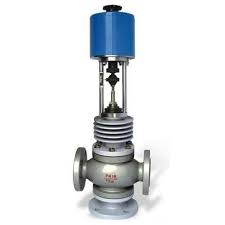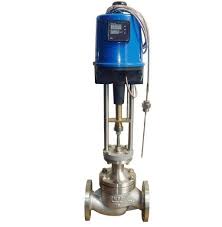Electric Temperature Control Valve

The Application of Electric Temperature Control Valve
In the realm of temperature regulation, Cameron stands at the forefront with its innovative solutions, including the electrical temperature control valve. Serving as a pinnacle in the industry, the Temperature Regulation Valve integrates advanced technology to ensure precise temperature management. With its intelligent features, the Smart Temperature Control Valve offers automated adjustments, optimizing processes across various sectors, from industrial to residential applications. Cameron’s commitment to excellence shines through its electric temperature control valves, delivering unparalleled reliability and efficiency in temperature regulation systems.
What Are The Types Of Electric Temperature Control Valve?
- Electric Globe Valve: Offers precise control over flow rates and is suitable for applications requiring accurate temperature regulation.
- Electric Ball Valve: Provides fast response times and is ideal for on/off control in HVAC systems and industrial processes.
- Electric Butterfly Valve: Features a compact design and is commonly used in HVAC and water treatment systems for temperature control.
- Electric Control Valve with Modulating Actuator: Allows for continuous adjustment of flow rates, ensuring precise temperature control in dynamic processes.
- Electric Zone Valve: Used in heating and cooling systems to control the flow of water or steam to specific zones, optimizing energy efficiency.
What Is Electric Temperature Control Valve?
An electric temperature control valve is a type of valve that utilizes electrical power to regulate the flow of fluid based on temperature parameters. It integrates sensors and actuators to automatically adjust the valve position, maintaining a desired temperature within a system. This sophisticated valve ensures precise temperature control, making it ideal for applications requiring accurate thermal management in various industries, including HVAC, process control, and water heating systems.
How to Select the Right Electric Temperature Control Valve?
To select the right electric temperature control valve, consider factors such as the desired temperature range, flow rate, and compatibility with the system. Evaluate the specific requirements for temperature regulation, such as accuracy and response time. Choose a valve with appropriate electrical specifications and control options to integrate seamlessly into the system’s automation infrastructure. Additionally, ensure the valve’s materials and construction meet the needs of the application environment in terms of pressure, temperature, and fluid compatibility.
Features of Electric Temperature Control Valve
- Precise Temperature Regulation:
- Utilizes advanced technology to maintain temperature within tight tolerances, ensuring optimal process conditions.
- Automated Control:
- Incorporates electronic actuators to adjust valve position automatically based on temperature setpoints, minimizing manual intervention.
- Flexible Control Options:
- Offers a range of control methods, including analog signals, digital communication protocols (e.g., Modbus, Profibus), and local control panels.
- Fast Response Time:
- Enables rapid adjustments to changing temperature conditions, ensuring quick system stabilization.
- Energy Efficiency:
- Helps optimize energy consumption by precisely regulating fluid flow, reducing unnecessary heating or cooling.
- Remote Monitoring and Control:
- Allows for remote monitoring and adjustment of temperature settings, enhancing system efficiency and convenience.
- Durable Construction:
- Built with robust materials to withstand harsh operating conditions, ensuring long-term reliability.
- Compatibility:
- Available in various sizes and configurations to suit different system requirements and installation environments.
Advantages and Disadvantages of Electric Temperature Control Valve
Advantages
- Precise Temperature Control:
- Ensures accurate and consistent temperature regulation, improving process efficiency.
- Automation:
- Reduces manual intervention by automatically adjusting valve position based on temperature setpoints.
- Flexibility:
- Offers multiple control options and compatibility with various automation systems.
- Energy Efficiency:
- Optimizes energy consumption by minimizing temperature fluctuations and unnecessary heating or cooling.
- Remote Monitoring:
- Allows for remote monitoring and adjustment, enhancing system control and management.
Disadvantages
- Cost:
- Initial investment can be higher compared to manual or simpler control methods.
- Complexity:
- Requires expertise in automation and control systems for installation, programming, and maintenance.
- Dependence on Electricity:
- Relies on electrical power for operation, which may pose challenges in case of power outages or electrical failures.
- Potential for Malfunction:
- Electronic components may be susceptible to failure or malfunction, requiring regular maintenance and troubleshooting.

The Specifications of Electric Temperature Control Valve
| Specification | Details |
|---|---|
| Type | Electric Temperature Control Valve |
| Ball Material | Stainless Steel |
| Attachment Type | Flanged |
| Thread Standard | ANSI B1.20.1 |
| Thread Size | 1 inch |
| Body Material | Brass |
| Safe for Use With | Water, Oil, Gas |
| Handle Type | Electric Actuator |
| Handle Material | Aluminum Alloy |
| Maximum Working Pressure (psi) | 250 psi |
| Maximum Working Pressure (bar) | 17.2 bar |
| Operating Pressure | 20-150 psi |
The Installation Steps for Electric Temperature Control Valve
- Preparation:
- Gather all necessary tools and equipment for installation.
- Ensure the work area is clean and free from debris.
- Valve Positioning:
- Determine the optimal location for the valve within the piping system.
- Consider factors such as accessibility, temperature sensor placement, and flow direction.
- Mounting:
- Securely mount the valve onto the pipeline using appropriate fittings and supports.
- Ensure proper alignment with the pipe to prevent leaks and optimize performance.
- Wiring:
- Connect the electrical wires from the valve actuator to the control system or power source.
- Follow the manufacturer’s instructions and wiring diagram for correct connection.
- Sensor Installation:
- Install temperature sensors at strategic points in the system, such as inlet and outlet pipes or process vessels.
- Ensure sensors are securely mounted and properly calibrated for accurate temperature readings.
- Testing:
- Power up the valve and verify its operation by sending control signals from the temperature control system.
- Monitor valve response and ensure it adjusts correctly based on temperature setpoints.
- Calibration:
- Fine-tune the valve settings and control parameters to achieve the desired temperature control accuracy.
- Verify the valve’s performance under different operating conditions.
- Final Checks:
- Inspect the installation for any leaks, loose connections, or abnormalities.
- Confirm that all components are functioning properly before putting the system into operation.
The Operation Theory of Electric Temperature Control Valve
- Temperature Sensing:
- Temperature sensors detect the temperature of the fluid within the system. These sensors are strategically placed at key points to provide accurate temperature readings.
- Signal Processing:
- The temperature readings are transmitted to the control unit, where they are analyzed and compared to the desired setpoints.
- Actuation:
- Based on the comparison between actual and desired temperatures, the control unit sends signals to the actuator of the valve.
- Valve Adjustment:
- The actuator adjusts the position of the valve, regulating the flow of fluid to achieve the desired temperature.
- Feedback Loop:
- Continuous monitoring and adjustment ensure that the system maintains temperature stability, with the feedback loop allowing for real-time corrections.
- Automation:
- The entire process is automated, allowing for seamless operation without manual intervention once the system is set up and configured.
- Precision Control:
- Precision temperature control valves offer enhanced accuracy and sensitivity, allowing for tight control over temperature variations.
The Parameters Chart of Electric Temperature Control Valve
| Parameter | Details |
|---|---|
| Valve Type | Electric Temperature Control Valve |
| Valve Material | Stainless Steel |
| Actuator Type | Electric |
| Actuator Material | Aluminum Alloy |
| Valve Size | 1 inch |
| Temperature Range | 0°C to 100°C |
| Flow Capacity | 10-100 GPM (Gallons per Minute) |
| Pressure Rating | 150 psi |
| Power Supply | 24 VDC |
| Control Signal | 4-20 mA |
| Accuracy | ±1°C |
| Response Time | <10 seconds |
| Ambient Temperature Range | -20°C to 60°C |
| End Connection | Flanged |
| Certifications | CE, ISO |
